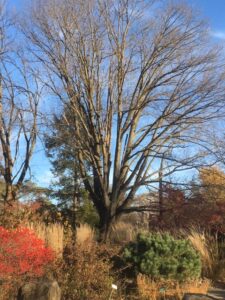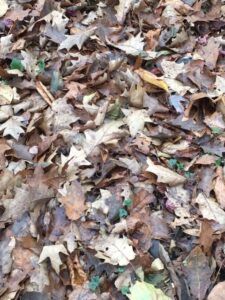Not only is the Columbus Park of Roses well known for its roses and other themed gardens, it is also a certified arboretum. While some visitors may not focus on the trees, they deserve attention. The oak tree species perhaps deserves the most attention. This point is convincingly made in a fairly recently published book, The Nature of Oaks: The Rich Ecology of Our Most Essential Native Trees, by well-known entomologist, Douglas Tallamy.

Oaks live a long time. Some in the CPOR were here long before the park was developed. The Northern Red Oak (seen here) just east of the Backyard Garden is easily over 100 years old. What it could tell us if it could talk! Another Red Oak in the CPOR that died two years ago, was also over 100 years old. You can see its large stump near the Perennial Garden. While we were very sad to lose it, its loss to the animals relying on it was more important. Oaks support more life-forms than any other North American tree. Oak trees support 897 species of caterpillars in the United States. Of the food eaten by insects, birds and other animals, 75% come from a few genus of plants and oaks are at the top of the list.
Oaks provide food in many ways. One is in the form of caterpillars which are seen by Tallamy as nutritious baby bird food. Also, one oak tree can produce three million acorns in its lifetime; an excellent source of protein, fat and carbohydrates for animals. The leaf litter under an oak tree is equally valuable. The diversity and abundance of the little creatures that reside in the leaf litter that accumulates beneath an oak tree is astounding, and easily exceeds counts in the millions.

Find and study the ten different oaks at the CPOR, many of which are labeled with their common and botanical names:
Bur Oak, Quercus macrocarpa
Chinquapin Oak, Quercus muehlenbergii
Oriental Oak, Quercus variabilis
Pin Oak, Quercus palustris
Scarlet Oak, Quercus coccinea
Shingle Oak, Quercus imbricaria
Shumard Oak, Quercus shumardii
Swamp Chestnut Oak, Quercus michauxii
White Oak, Quercus bicolor
Are you also an oak tree lover? Do you have one in your yard? If not, plant an acorn and watch one grow.
Source:
The Nature of Oaks: The Rich Ecology of Our Most Essential Native Trees, Douglas Tallamy, 2021.

“The acorn doesn’t fall from the tree”